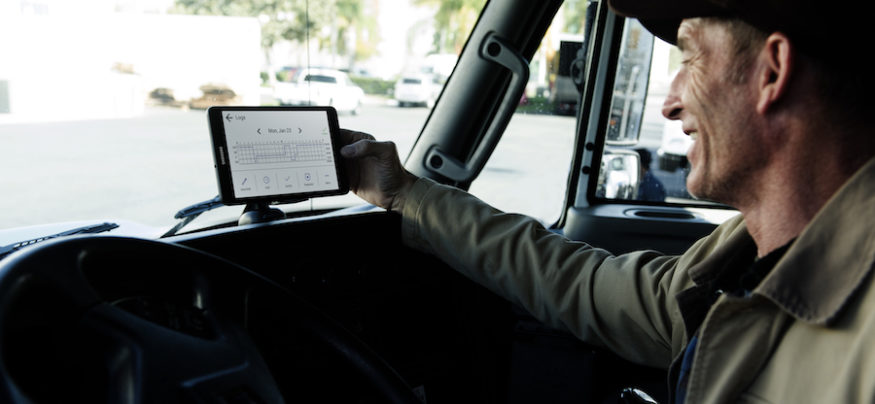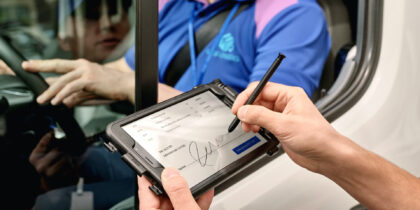Smart wearable devices that enable fleet managers to send up-to-date communications to truckers have the potential to dramatically impact the future of the industry. Fleet safety is a top concern in the trucking industry, and wearables can play a key role by enhancing communication between drivers and managers.
Wearable devices now represent a compelling option for connecting to the internet of things (IoT), linking people and data while improving productivity, efficiency and safety. A basic type of wearable, the Bluetooth-enabled headset, has been a staple for trucker drivers ever since smartphones and tablets came into the cab, making hands-free voice communication a daily part of a driver’s life.
Today, wearables are taking on many forms: fitness trackers, cameras, smartwatches, GPS tracking devices, wearable fabrics and head-mounted displays. Some wearable devices even integrate the functions of multiple devices.
Staying in Touch on the Road
For trucking companies, the most important benefit of wearables is the ability “to allow the wearer to access data from anywhere. These devices can bring significant advantages in the areas of driver performance, driver safety and security, and driver health,” said Bart De Muynck, research director at Gartner.
Smartwatches are gaining ground in the truck cab, supplementing smartphones and tablets that drivers use to communicate and manage their workflow. Ideal for quick notifications or alerts, Samsung wearables such as the Galaxy Watch can also be customized to enhance productivity for workers whose job responsibilities require hands-free access to data. In transportation, fleet managers could send route updates and other information to a smartwatch for quick driver reference, and drivers could also use smartwatches to view their hours of service, allowing them to stay up to date at a glance.
How to Modernize Fleet Management
Get your free guide to improving fleet performance and profitability with in-cab mobile technology. Download Now
Fleet management and telematics technology companies have begun to roll out their own apps to improve communication and data tracking, such as PeopleNet’s ConnectedDriver app, which allows drivers to send or receive messages via their trucks’ telematics and communications systems. Developers are also working on smartwatch apps that connect to the truck’s telematics system to track events such as rapid acceleration, hard braking and on-time arrivals. With this data, managers can gamify fleet safety by rating a driver’s performance against their peers. It’s easy for drivers to quickly glance down at their smartwatches to view their data, and it can encourage healthy competition among drivers to get the best scores.
Another benefit of a smartwatch is the use of haptic feedback, or the sense of touch. A watch can vibrate or tap the wearer, as an alert to get the driver’s attention but not distracting their gaze while driving. A smartwatch can also send a haptic alert when a driver exceeds a preset speed limit, or a navigation update when a turn is coming up soon. With haptic feedback, smartwatches can communicate with the driver while avoiding distractions.
Wearables Drive Fleet Safety
Use cases for wearable devices are developing in a number of fleet operations, and provide benefits that enhance both vehicle and driver safety and performance.
- Driver Performance: Wearables can track driver activity on and off the job, helping improve fleet safety by reducing fatigue-related accidents. They can also track driver behavior through the telematics system to improve performance and highway safety.
- Vehicle Safety: A smartwatch could send a vibration alert to a driver making a lane change if a car is detected in the truck’s blind spot. Alerts could also be set for other events such as a truck or trailer door opening while the truck is parked.
- Driver Safety: A smartwatch could be set to send an alert to fleet headquarters or call 911 with one button press in case of an emergency. A watch could even automatically call for help if it senses a driver falling or losing consciousness.
In addition to smartwatches, companies are developing other forms of wearable devices. Sensor-equipped helmets and hats can monitor drivers for fatigue, whether by measuring head movements or scanning brainwaves, and send an alert to the driver as well as fleet managers. A smart shirt, equipped with biometric sensors, can track a driver’s physiology to develop health and fitness indicators that could lead to better health and performance.
While most trucking experts say widespread use of wearable devices may still be in the future, companies are already exploring their ability to boost efficiency and driver safety. Wearables are one more way that leading fleets can employ state-of-the-art technology to remain competitive for the long haul.
Learn more about Samsung’s connected fleet solutions that can help you meet company and driver needs. Read a free white paper on how to develop new and innovative wearable apps tailored precisely to your business needs.









